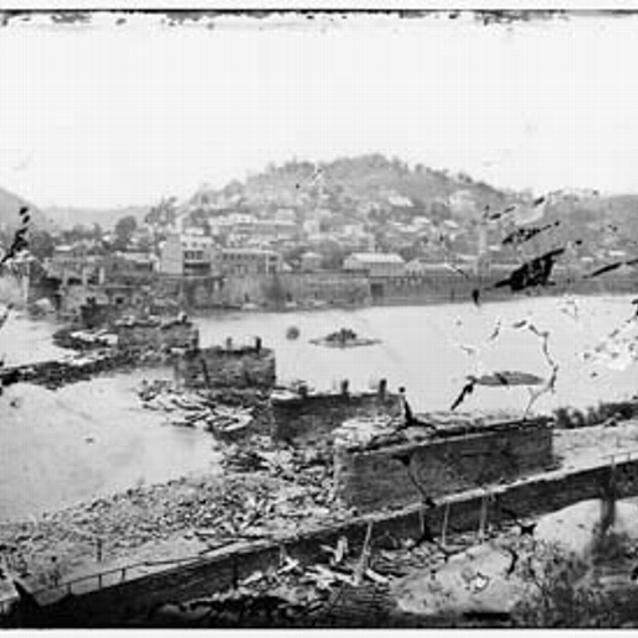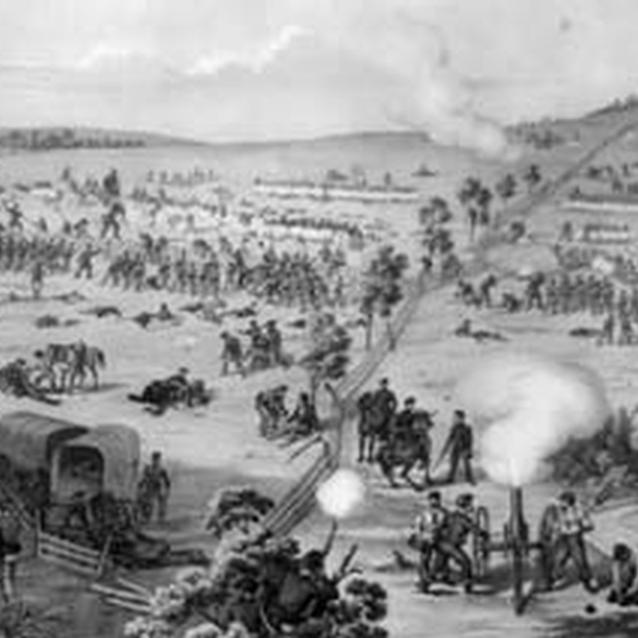As Lee's army moved north through Frederick, he expected some 14,000 Federal troops garrisoned at Harpers Ferry and Martinsburg to withdraw. Lee's plans depended upon it - the Confederates needed the Shenandoah Valley as their line of supply and communication while they campaigned north of the Potomac. The Federals, however, refused to withdraw, forcing Lee into a quandary.
"Two miles away on our right, long lines and heavy columns of dark blue infantry could be seen pressing up the green slopes of the mountain, their bayonets flashing like silver in the rays of the setting sun." Major Rufus Dawes, 6th Wisconsin Infantry
The Battle of Harpers Ferry

Library of Congress
Harpers Ferry was a key supply base for Union operations in the Shenandoah Valley, and served to protect the C&O Canal and B&O Railroad - important Union transportation corridors. Lee could not move north without neutralizing the Harpers Ferry garrison.
Believing that Union forces were in "a very demoralized and chaotic condition" following their defeat at Second Manassas in Virginia, and that McClellan was "an able general but a very cautious one," Lee decided to divide his army into four parts. Special Orders 191 contained all the operational details: three separate columns totaling almost 23,000 men would march on Harpers Ferry, surround the place, and capture or destroy the garrison there. Lee selected Jackson to lead the assault.
With Gen. John G. Walker holding Loudoun Heights and Gen. Lafayette McLaws in position on Maryland Heights, Jackson tightened the noose on the federal garrison from his position on School House Ridge. The Confederate artillery fire upon Harpers Ferry was effective and demoralizing. Union Col. William Trimble of the 60th Ohio wrote that there was "not a place where you could lay the palm of your hand and say it was safe."
Realizing that artillery alone would not subdue the Federal garrison, Jackson ordered Gen.A.P. Hill and Col. Crutchfield, his Chief of Artillery, to flank the Union position on Bolivar Heights. Using School House Ridge for cover, 3,000 men moved toward the Shenandoah River. Hill dragged twenty guns up the river's steep bluffs, and succeeded in planting his artillery 1,000 yards from the exposed Union left flank. Crutchfield crossed the Shenandoah River and hauled ten guns up to Loudoun Heights. Hill later wrote that "the fate of Harpers Ferry was sealed."
On the morning of September 15th, the Union Col. Dixon Miles held a council of war. Surrounded by a force twice the size of their own and out of long range artillery ammunition, the officers unanimously agreed to surrender. At around 9:00 a.m., white flags were raised by Union troops all along Bolivar Heights. Jackson captured over 12,500 soldiers at Harpers Ferry - the largest single capture of American forces until World War II.
The Battle of South Mountain

Library of Congress
On September 14th, 1862, lead elements of the Union army pursuing the Confederates west of Frederick met stiff resistance in key gaps along South Mountain. Confederate rear guards were left to protect vital passes through South Mountain, while Jackson took Harpers Ferry and Longstreet moved towards Hagerstown. McClellan directed his army to drive forward through the passes and split the Confederate forces.
At 9:00 a.m. the Union Ninth Corps began its assault on Fox's Gap to dislodge troops under the command of Confederate Gen. D.H. Hill, while the First Corps moved into position to the north against Turner's and Frostown Gaps. After a brief lull in the fighting around noon, the Federal attacks resumed around midday with combined assaults on Fox's, Turner's and Frostown. After hours of nonstop combat the Federals eventually dislodged the Confederate defenders. The fighting for the northern gaps ended late in the evening with soldiers firing blindly into the woods and rocky slopes at opposing muzzle flashes.
When the fighting for Fox's, Turner's and Frostown Gaps was over, Union Gen. Jesse Lee Reno, and Confederate Gen. Samuel Garland were dead, Union First Corps division commander Gen. John Hatch was seriously wounded, and almost 4,000 Union and Confederate soldiers were killed, wounded or missing.
About six miles to the south another goal had to be reached - Gen. William B. Franklin's Sixth Corps was given the daunting task of striking the Confederate forces around Harpers Ferry. After moving slowly forward and waiting on the outskirts of Burkittsville, Maryland, Franklin finally ordered his 12,000 man corps to assault Crampton's Gap. Unprepared for a large assault, the small Confederate force there, numbering roughly 1,200 men, held firm for a short period until the Federal force overwhelmed them on both front and flank.
Though the Battle of South Mountain was a Confederate defeat, it delayed the Federal army just long enough to allow "Stonewall" Jackson's wing to capture the garrison at Harpers Ferry, while the remaining elements of Longstreet's wing, garnering supplies from Hagerstown, could regroup at a location designated by Lee: Sharpsburg, Maryland.
Part of a series of articles titled A Savage Continual Thunder.
Previous: Crossing Over
Last updated: February 4, 2015
